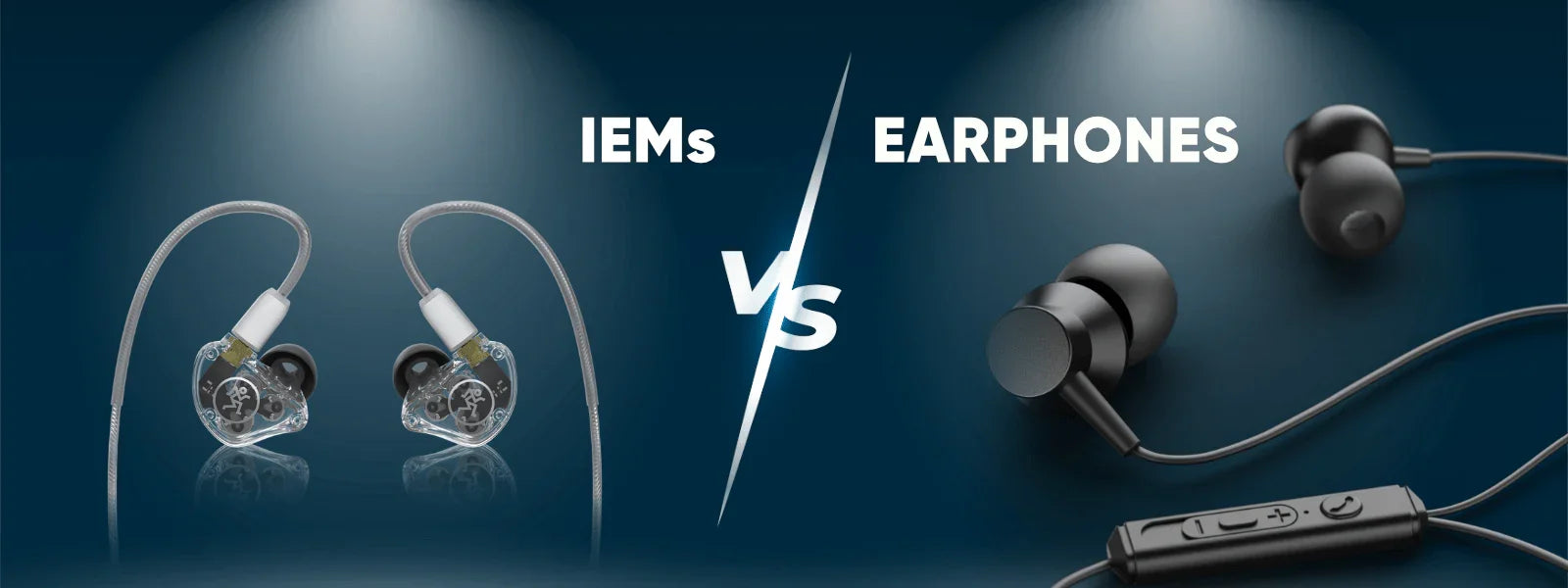The terms “IEMs” and “earphones” are often used interchangeably in the personal audio industry. But they are not the same. The difference may seem slight to casual listeners, but knowing what goes into the contrast between in-ear monitors vs earphones can really uplift the experience for audiophiles, musicians, and even gamers.
Design & Fit: Built for Purpose
In the IEMs vs earphones comparison, the immediate distinction lies in design and fit. Earphones generally rest just inside the outer ear without sealing the ear canal. Meaning, you can hear quite a bit of sound from the back; it very well could be a feature or could turn out as a disadvantage depending on the use.
IEMs, in contrast, are designed to be inserted deeper into the ear canal. A tighter seal is created with noise isolation and fine audio delivery. That is why, when it comes to the IEM vs earphones debate, IEMs are held in high preference by performers on stage and studio professionals. Custom or multiple ear tip sizes, allow for more control and comfort across different ear types.
Sound Quality: Precision vs Casual Listening
When In ear monitors vs earphones are compared for audio quality. IEMs usually come ahead. They are manufactured with accuracy in mind, with their target being a flatter frequency response suitable for mixing, monitoring, and analysing subtle musical tones.
By contrast, earphones generally come with some sort of bass or treble boost intended to please the regular listener. Great for casual listening, podcasts, or quick phone calls; however, in professional settings or critical listening, IEMs are preferred.
Elver Buds X Dual ANC+ENC True Wireless Earbuds come with features like 13mm dynamic drivers, environmental noise cancellation, and a frequency response range of about 20–20 kHz. These make Elver X a strong option for casual listeners looking for quality sound in a portable and wireless design.
Use Case: Professional vs General
One of the most important aspects in an IEM vs earphones comparison lies in the intended use. IEMs have been designed for musicians, sound engineers, and performers who need real-time, accurate sound feedback in noisy environments.
Earphones, meanwhile, are intended for everyday use—commuting, casual music, or calls. However, with advancements in technology, some earbuds now deliver a hybrid performance. Devices offer consumer-level ease of use, touch controls, and cross-device compatibility.
So, when IEMs vs earphones are discussed in today’s market, the gap is narrowing due to innovations in wireless audio, such as Bluetooth 5.3, found in the latest Elver Buds X Dual ANC+ENC True Wireless Earbuds.
Portability & Connectivity
While compact and portable, earphones are usually a bit simpler when it comes to wired or wireless design. IEMs might actually demand amplification and/or custom setups, especially at the very high end.
Comparison Table: IEMs vs Earphones
|
Feature |
In-Ear Monitors (IEMs) |
Earphones |
|---|---|---|
|
Design & Fit |
Inserted deep into the ear canal, a snug seal |
Rests on the outer ear, minimal seal |
|
Sound Signature |
Flat and neutral for detailed monitoring |
Tuned for fun listening with boosted bass/treble |
|
Noise Isolation |
High passive isolation due to deeper fit |
Low to moderate isolation |
|
Target Audience |
Musicians, audiophiles, and studio professionals |
Casual listeners, commuters, and phone users |
|
Comfort |
Comes with custom/multiple ear tips |
Basic fit, limited customisation |
|
Connectivity |
Often wired, may need amplifiers |
Wired and wireless; easy plug-and-play |
|
Use Case |
Monitoring, live performance, critical listening |
Calls, podcasts, and music playback |
|
Price Range |
Medium to High |
Budget to Medium |
Conclusion: Choosing What’s Right for You
The IEM vs earphones choice has a lot to do with how sound is being consumed. IEMs are the clear choice for professionals and people who seek pure sound. Wired Earphones might be good enough for everyday listeners. However, with users now enjoy features from both categories that they have to offer.
Goals of level-one choice include high-fidelity listening, immersive gaming, or clear-cut calls. Understanding the debate between In ear monitors vs earphones will, in turn, lead users toward the right choice.









